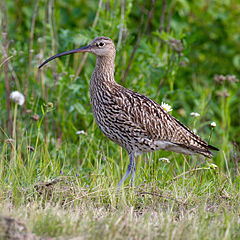Eurasian curlew
| Eurasian curlew | |
|---|---|
 |
|
| Scientific classification | |
| Kingdom: | |
| Phylum: | |
| Class: | |
| Subclass: | |
| Infraclass: | |
| Superorder: | |
| Order: | |
| Suborder: |
Scolopaci
|
| Family: | |
| Genus: | |
| Species: |
N. arquata
|
| Binomial name | |
| Numenius arquata |
|
| File:Eurasian Curlew Range.png | |
| Global range Year-Round Range Summer Range Winter Range | |
Lua error in Module:Taxonbar/candidate at line 22: attempt to index field 'wikibase' (a nil value).
The Eurasian curlew (Numenius arquata) is a wader in the large family Scolopacidae. It is one of the most widespread of the curlews, breeding across temperate Europe and Asia. In Europe, this species is often referred to just as the "curlew", and in Scotland known as the "whaup" in Scots.
This is the largest wader in its range, at 50–60 cm (20–24 in) in length, with a 89–106 cm (35–42 in) wingspan and a body weight of 410–1,360 g (0.90–3.00 lb).[2] It is mainly greyish brown, with a white back, and a very long curved bill. Males and females look identical, but the bill is longest in the adult female. It is generally not possible to recognize the sex of a single Eurasian curlew, or even several ones as there is much variation; telling male and female of a mated pair apart is usually possible however.
The familiar call, from which this bird gets it name, is a loud curloo-oo.
The only similar species over most of the curlew's range is the whimbrel (N. phaeopus). The whimbrel is smaller and has a shorter bill with a kink rather than a smooth curve. Flying curlews may also resemble, albeit not existing in the same area, bar-tailed godwits (Limosa lapponica) in their winter plumages; however, the latter have a smaller body, a slightly upturned beak, and legs that do not reach far beyond their tail tips. The Eurasian curlew's feet are longer, forming a conspicuous "point".
The curlew exists as a migratory species over most of its range, wintering in Africa, southern Europe and south Asia. Occasionally a vagrant individual reaches places far from its normal range, such as Nova Scotia[3] and the Marianas.[4] It is present all year in the milder climates of the United Kingdom and its adjacent European coasts.
Subspecies
There are three subspecies of the Eurasian curlew:
- N. a. arquata, (Linnaeus, 1758): breeds in west, north & central Europe.
- N. a. orientalis, (Brehm, 1831): breeds in west & central Siberia through to Northeast China.
- N. a. suschkini, (Neumann, 1929): breeds from western Kazakhstan to southwestern Siberia.
It is generally wary. Highly gregarious outside the breeding season, the Eurasian curlew feeds by probing soft mud for small invertebrates, but will also pick small crabs and earthworms off the surface if the opportunity arises.
-
Eggs Numenius arquata.jpg
clutch of eggs
The nest is a bare scrape on taiga, meadow, and similar habitats. Each curlew lays between 3 and 6 eggs in April or May and incubates them for about a month until they begin to hatch.
The curlew is one of the species to which the Agreement on the Conservation of African-Eurasian Migratory Waterbirds (AEWA) applies.
Formerly classified as a species of Least Concern by the IUCN, it was suspected to be rarer than generally assumed. Following the evaluation of its population size, the classification was found to be incorrect, and it was consequently promoted to Near Threatened status in 2008. Though it is a common bird, its numbers are noticeably declining.[5] In Ireland, for example, the breeding population is estimated to have declined by 86% in the last 30 years.[6]
Footnotes
- ↑ Lua error in package.lua at line 80: module 'strict' not found.
- ↑ CRC Handbook of Avian Body Masses by John B. Dunning Jr. (Editor). CRC Press (1992), ISBN 978-0-8493-4258-5.
- ↑ NHMNS (1998)
- ↑ Wiles et al. (2000, 2004)
- ↑ BLI (2008)
- ↑ Maguire, Stephen "Endangered Curlew- Conservation drive started to save species" Irish Times 28/02/2014
References
- Natural History Museum of Nova Scotia (NHMNS) (1998): Birds of Nova Scotia – Eurasian Curlew. Retrieved 2008-MAY-23.
- Wiles, Gary J.; Worthington, David J.; Beck, Robert E. Jr.; Pratt, H. Douglas; Aguon, Celestino F. & Pyle, Robert L. (2000): Noteworthy Bird Records for Micronesia, with a Summary of Raptor Sightings in the Mariana Islands, 1988–1999. Micronesica 32(2): 257–284. PDF fulltext
- Wiles, Gary J.; Johnson, Nathan C.; de Cruz, Justine B.; Dutson, Guy; Camacho, Vicente A.; Kepler, Angela Kay; Vice, Daniel S.; Garrett, Kimball L.; Kessler, Curt C. & Pratt, H. Douglas (2004): New and Noteworthy Bird Records for Micronesia, 1986–2003. Micronesica 37(1): 69–96. HTML abstract
External links
| Wikimedia Commons has media related to Lua error in package.lua at line 80: module 'strict' not found.. |
- (Eurasian) curlew – Species text in The Atlas of Southern African Birds.
- Eurasian curlew videos, photos & sounds on the Internet Bird Collection
- Probing the Thames Estuary
Lua error in package.lua at line 80: module 'strict' not found.
